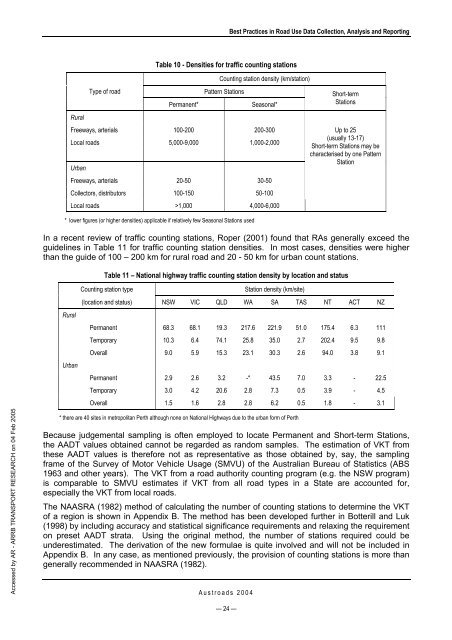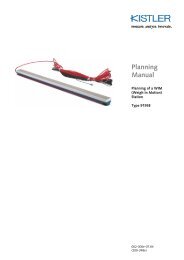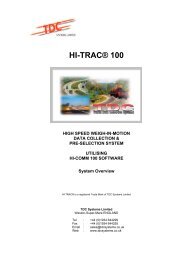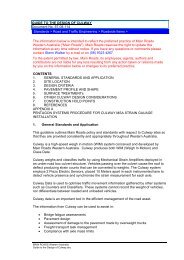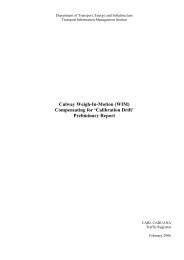AP-G84/04 Best practice in road use data collection, analysis ... - WIM
AP-G84/04 Best practice in road use data collection, analysis ... - WIM
AP-G84/04 Best practice in road use data collection, analysis ... - WIM
Create successful ePaper yourself
Turn your PDF publications into a flip-book with our unique Google optimized e-Paper software.
Accessed by AR - ARRB TRANSPORT RESEARCH on <strong>04</strong> Feb 2005<br />
Rural<br />
Type of <strong>road</strong><br />
Table 10 - Densities for traffic count<strong>in</strong>g stations<br />
Aust<strong>road</strong>s 20<strong>04</strong><br />
— 24 —<br />
<strong>Best</strong> Practices <strong>in</strong> Road Use Data Collection, Analysis and Report<strong>in</strong>g<br />
Count<strong>in</strong>g station density (km/station)<br />
Pattern Stations<br />
Permanent* Seasonal*<br />
Freeways, arterials 100-200 200-300<br />
Local <strong>road</strong>s 5,000-9,000 1,000-2,000<br />
Urban<br />
Freeways, arterials 20-50 30-50<br />
Collectors, distributors 100-150 50-100<br />
Local <strong>road</strong>s >1,000 4,000-6,000<br />
* lower figures (or higher densities) applicable if relatively few Seasonal Stations <strong>use</strong>d<br />
Short-term<br />
Stations<br />
Up to 25<br />
(usually 13-17)<br />
Short-term Stations may be<br />
characterised by one Pattern<br />
Station<br />
In a recent review of traffic count<strong>in</strong>g stations, Roper (2001) found that RAs generally exceed the<br />
guidel<strong>in</strong>es <strong>in</strong> Table 11 for traffic count<strong>in</strong>g station densities. In most cases, densities were higher<br />
than the guide of 100 – 200 km for rural <strong>road</strong> and 20 - 50 km for urban count stations.<br />
Rural<br />
Urban<br />
Table 11 – National highway traffic count<strong>in</strong>g station density by location and status<br />
Count<strong>in</strong>g station type Station density (km/site)<br />
(location and status) NSW VIC QLD WA SA TAS NT ACT NZ<br />
Permanent 68.3 68.1 19.3 217.6 221.9 51.0 175.4 6.3 111<br />
Temporary 10.3 6.4 74.1 25.8 35.0 2.7 202.4 9.5 9.8<br />
Overall 9.0 5.9 15.3 23.1 30.3 2.6 94.0 3.8 9.1<br />
Permanent 2.9 2.6 3.2 -* 43.5 7.0 3.3 - 22.5<br />
Temporary 3.0 4.2 20.6 2.8 7.3 0.5 3.9 - 4.5<br />
Overall 1.5 1.6 2.8 2.8 6.2 0.5 1.8 - 3.1<br />
* there are 40 sites <strong>in</strong> metropolitan Perth although none on National Highways due to the urban form of Perth<br />
Beca<strong>use</strong> judgemental sampl<strong>in</strong>g is often employed to locate Permanent and Short-term Stations,<br />
the AADT values obta<strong>in</strong>ed cannot be regarded as random samples. The estimation of VKT from<br />
these AADT values is therefore not as representative as those obta<strong>in</strong>ed by, say, the sampl<strong>in</strong>g<br />
frame of the Survey of Motor Vehicle Usage (SMVU) of the Australian Bureau of Statistics (ABS<br />
1963 and other years). The VKT from a <strong>road</strong> authority count<strong>in</strong>g program (e.g. the NSW program)<br />
is comparable to SMVU estimates if VKT from all <strong>road</strong> types <strong>in</strong> a State are accounted for,<br />
especially the VKT from local <strong>road</strong>s.<br />
The NAASRA (1982) method of calculat<strong>in</strong>g the number of count<strong>in</strong>g stations to determ<strong>in</strong>e the VKT<br />
of a region is shown <strong>in</strong> Appendix B. The method has been developed further <strong>in</strong> Botterill and Luk<br />
(1998) by <strong>in</strong>clud<strong>in</strong>g accuracy and statistical significance requirements and relax<strong>in</strong>g the requirement<br />
on preset AADT strata. Us<strong>in</strong>g the orig<strong>in</strong>al method, the number of stations required could be<br />
underestimated. The derivation of the new formulae is quite <strong>in</strong>volved and will not be <strong>in</strong>cluded <strong>in</strong><br />
Appendix B. In any case, as mentioned previously, the provision of count<strong>in</strong>g stations is more than<br />
generally recommended <strong>in</strong> NAASRA (1982).


